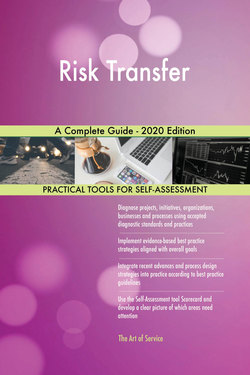Читать книгу Risk Transfer A Complete Guide - 2020 Edition - Gerardus Blokdyk - Страница 10
На сайте Литреса книга снята с продажи.
ОглавлениеCRITERION #4: ANALYZE:
INTENT: Analyze causes, assumptions and hypotheses.
In my belief, the answer to this question is clearly defined:
5 Strongly Agree
4 Agree
3 Neutral
2 Disagree
1 Strongly Disagree
1. What are the key findings of the data?
<--- Score
2. Is the performance gap determined?
<--- Score
3. Are there enough various data available for statistical modelling purposes?
<--- Score
4. How sensitive is the data, and what are the necessary minimum security controls?
<--- Score
5. What are the greatest opportunities for your organization?
<--- Score
6. How will the data be checked for quality?
<--- Score
7. Is the Risk transfer process severely broken such that a re-design is necessary?
<--- Score
8. Does your investment process allow short-selling?
<--- Score
9. How was the detailed process map generated, verified, and validated?
<--- Score
10. Can the data and service be easily moved to another provider?
<--- Score
11. Were any designed experiments used to generate additional insight into the data analysis?
<--- Score
12. What Risk transfer data should be managed?
<--- Score
13. Who should be involved in the evaluation process, and who makes the decisions?
<--- Score
14. Were Pareto charts (or similar) used to portray the ‘heavy hitters’ (or key sources of variation)?
<--- Score
15. What quality tools were used to get through the analyze phase?
<--- Score
16. Are gaps between current performance and the goal performance identified?
<--- Score
17. What are the revised rough estimates of the financial savings/opportunity for Risk transfer improvements?
<--- Score
18. What quality control measures will be used when entering data?
<--- Score
19. Do you believe that acceptance of data sharing will increase overall?
<--- Score
20. Where are you seeing growth opportunities for captives today?
<--- Score
21. What did the team gain from developing a sub-process map?
<--- Score
22. What are the processes for audit reporting and management?
<--- Score
23. Which data needs to be collected to implement the mentioned approaches?
<--- Score
24. Did any additional data need to be collected?
<--- Score
25. What tools were used to generate the list of possible causes?
<--- Score
26. How is the confidentiality, integrity and availability of data maintained?
<--- Score
27. What is the cost of poor quality as supported by the team’s analysis?
<--- Score
28. How does your organization identify opportunities for innovation?
<--- Score
29. When should a process be art not science?
<--- Score
30. Was a cause-and-effect diagram used to explore the different types of causes (or sources of variation)?
<--- Score
31. Are internal controls inadequate in your organizations data processing area?
<--- Score
32. Was a detailed process map created to amplify critical steps of the ‘as is’ stakeholder process?
<--- Score
33. What systems/processes must you excel at?
<--- Score
34. Where will multiple data backups be stored?
<--- Score
35. What Risk transfer data will be collected?
<--- Score
36. How will data security be managed?
<--- Score
37. Were there any improvement opportunities identified from the process analysis?
<--- Score
38. Did any value-added analysis or ‘lean thinking’ take place to identify some of the gaps shown on the ‘as is’ process map?
<--- Score
39. Why does the new data contradict the old data?
<--- Score
40. Who will facilitate the team and process?
<--- Score
41. What types of opportunities and what level of risk require a formal response strategy?
<--- Score
42. What were the crucial ‘moments of truth’ on the process map?
<--- Score
43. What conclusions were drawn from the team’s data collection and analysis? How did the team reach these conclusions?
<--- Score
44. Is the gap/opportunity displayed and communicated in financial terms?
<--- Score
45. Is there a solution that can address the main concerns of all key stakeholders in the process?
<--- Score
46. What does the data say about the performance of the stakeholder process?
<--- Score
47. Why do other organizations choose fronting as an integral part of overall risk management process?
<--- Score
48. How will corresponding data be collected?
<--- Score
49. Which opportunities and what level of risk exposure require immediate action?
<--- Score
50. Can the data be encrypted in transit and/or at rest?
<--- Score
51. What were the financial benefits resulting from any ‘ground fruit or low-hanging fruit’ (quick fixes)?
<--- Score
52. What opportunities does Brexit provide captives?
<--- Score
53. Is the data subject to regulation?
<--- Score
54. Have any additional benefits been identified that will result from closing all or most of the gaps?
<--- Score
55. How is data used for program management and improvement?
<--- Score
56. Is there any way to speed up the process?
<--- Score
57. How will data be formatted for storage and accessibility?
<--- Score
58. Is data and process analysis, root cause analysis and quantifying the gap/opportunity in place?
<--- Score
59. What tools were used to narrow the list of possible causes?
<--- Score
60. Where do you see the greatest opportunities for captive development going forward?
<--- Score
61. Have the problem and goal statements been updated to reflect the additional knowledge gained from the analyze phase?
<--- Score
Add up total points for this section: _____ = Total points for this section
Divided by: ______ (number of statements answered) = ______ Average score for this section
Transfer your score to the Risk transfer Index at the beginning of the Self-Assessment.
